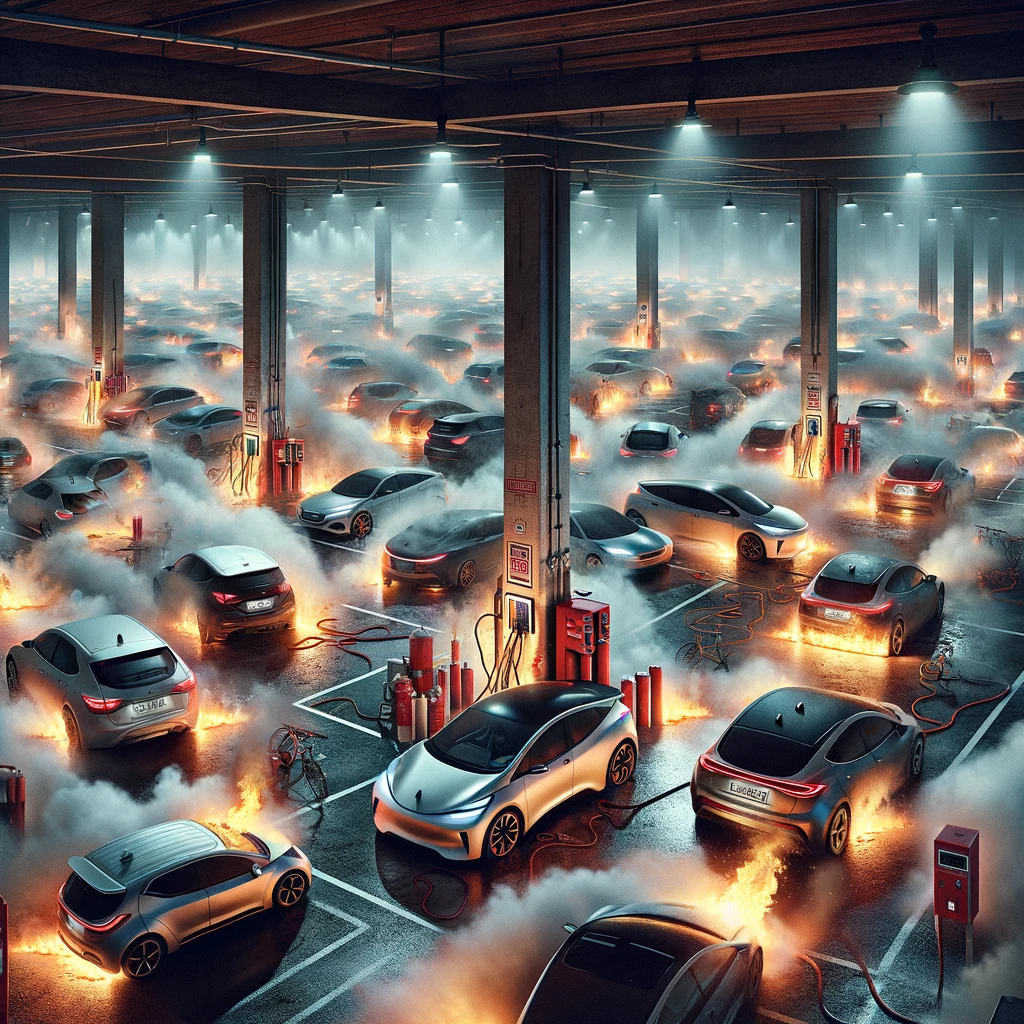Navigating the New Challenges
Introduction
The advent of electric vehicles (EVs) marks a pivotal move towards sustainable transportation, a shift that carries profound implications for environmental conservation and energy utilization. However, as we embrace this green revolution, it’s becoming increasingly apparent that our existing infrastructure, particularly within the realm of building fire safety, is encountering unforeseen challenges. Traditional fire sprinkler systems, which play a crucial role in safeguarding lives and property against fire incidents, are now at the forefront of these challenges, necessitating a reevaluation of their efficacy in the face of potential fire risks posed by EVs.

Electric vehicles, while eco-friendly, introduce a new dimension of fire risk, primarily due to their reliance on lithium-ion batteries. These batteries, known for their high energy density, can, under certain conditions, become a source of intense fires. Such fires can be triggered by thermal runaway, a process where an increase in temperature causes a further increase in temperature, often leading to a fire or explosion. The nature of these fires, including their intensity and the chemicals involved, poses a significant challenge to traditional fire suppression systems, including sprinklers.
Traditional fire sprinkler systems are designed based on the premise of combating conventional fires, such as those fueled by paper, wood, or cloth. These systems detect heat, prompting the release of water to suppress the fire. However, the unique characteristics of EV fires, including their higher heat intensity and potential chemical complexities, demand a nuanced approach to suppression. The water from sprinkler systems may not be as effective in cooling down lithium-ion battery fires or may interact unpredictably with the chemicals released during such fires.
Moreover, the location of EVs within buildings, often in underground parking facilities, adds another layer of complexity to fire safety strategies. The confined spaces, limited ventilation, and proximity to critical structural elements of buildings amplify the challenges faced by fire safety systems. In such environments, the effectiveness of traditional sprinkler systems in controlling or mitigating EV fires needs thorough examination and likely, adaptation.
This evolving risk landscape calls for a concerted effort from researchers, engineers, fire safety professionals, and policymakers. There’s a pressing need to develop new standards and technologies that can effectively detect, manage, and extinguish fires involving electric vehicles within buildings. This includes exploring advancements in sprinkler system design, such as sprinklers that can deliver fire-suppressing agents specifically formulated for chemical and electrical fires, and integrating smart fire detection systems that can more accurately assess and respond to the unique hazards presented by EVs.
Furthermore, as the EV market continues to expand, and more electric vehicles find their way into the garages and parking structures of homes and businesses, the integration of fire safety measures into the design and operation of EV charging stations becomes paramount. This includes ensuring that charging systems are equipped with safety features to prevent overheating and electrical faults, which are potential fire triggers.
In delving into the intersection of electric vehicles and building fire safety systems, this article seeks to underscore the complexities at play and the imperative for innovative solutions. By drawing insights from recent research and industry practices, we aim to highlight the emerging challenges and propose considerations for enhancing safety measures. As we navigate this new frontier, the goal remains clear: to ensure that our stride towards sustainable transportation does not compromise the safety of our built environment.

Challenges Posed by Electric Vehicles to Fire Sprinkler Systems
- Activation Mechanisms and EV Fires: Traditional fire sprinkler systems are activated by heat. However, EV fires, especially those stemming from battery malfunctions, can present different thermal profiles compared to conventional fires. Research by Babikov et al. (2019) underscores the need for adaptive sprinkler systems capable of recognizing and responding to such unique fire characteristics efficiently. (Read more)
- Electrical Fires in Buildings: Eaton (1992) discusses the broader context of electrical fires within buildings, emphasizing that while external power supply issues rarely cause these fires, the internal systems and equipment pose significant risks. This insight is crucial for understanding the implications of EV charging stations within buildings, necessitating enhanced fire safety protocols. (Read more)
- Smart Fire Safety Systems: The integration of smart technologies in fire safety systems, as explored by Tayab Mustaq Ahmed (2018), offers promising solutions. These systems can strategically activate sprinklers while managing electrical circuits to prevent exacerbating the fire, a concept that could be particularly effective in EV-related incidents. (Read more)
- Inadvertent Sprinkler Activation: With the addition of EV charging infrastructure, buildings might see an increased risk of inadvertent sprinkler activation. Blum et al. (2012) highlight the importance of understanding these risks to prevent unnecessary water damage and operational disruptions. (Read more)
- Understanding EV Fire Hazards: Dorsz and Lewandowski (2021) analyze the fire hazards associated with EVs, particularly in enclosed structures like parking garages. This research is critical for developing fire safety strategies that are specifically tailored to mitigate the risks posed by EV batteries and charging systems. (Read more)

Mitigation Strategies and Considerations
- Adaptive Sprinkler Systems: Develop and implement sprinkler systems with activation mechanisms sensitive to the unique characteristics of EV fires, including those involving lithium-ion batteries.
- Enhanced Safety Protocols: Building codes and safety protocols should be updated to address the specific challenges of EV charging stations, focusing on electrical fire prevention and containment.
- Smart Safety Technologies: Incorporate smart fire safety technologies that can simultaneously manage electrical hazards and activate fire suppression systems, ensuring a coordinated response to fires involving EVs.
- Risk Assessment for EV Infrastructure: Conduct thorough risk assessments for buildings with EV charging infrastructure to understand potential fire hazards and devise effective mitigation strategies.
- Research and Development: Support ongoing research into the behavior of EV fires and the effectiveness of various fire suppression techniques, facilitating the development of targeted safety measures.

Conclusion
As electric vehicles (EVs) become increasingly prevalent, the task of ensuring the compatibility of building fire safety systems with the unique challenges they present becomes not just advisable, but imperative. This critical undertaking encompasses a dual approach: firstly, adapting existing technologies to meet new demands, and secondly, fostering innovation in fire safety measures to address challenges proactively.
The nuances of EV-related fires are markedly different from traditional fire hazards. For instance, the high-density energy storage in EV batteries can lead to intense thermal events characterized by rapid heat release rates and potentially hazardous chemical reactions. Addressing these specific characteristics requires a holistic understanding of how EV fires initiate, propagate, and can be effectively controlled or extinguished. This knowledge then needs to be integrated into the design and operation of fire safety systems within buildings.
Integrating smart technologies stands out as a particularly promising avenue for enhancing the capability of fire safety systems to manage these new risks. Smart detection systems, for example, can offer more precise monitoring, allowing for the early detection of unusual heat signatures or chemical releases that could indicate the beginning stages of an EV battery fire. These systems could then trigger tailored fire suppression responses that are specifically designed for the type of fire event associated with EVs.
Furthermore, adaptive fire suppression technologies are crucial. These could include advanced sprinkler systems capable of deploying different suppression agents depending on the nature of the fire—whether it’s a conventional fire or one involving electrical components and battery materials. This adaptive capability would ensure that the response is both effective and minimizes damage to surrounding property.
Collaboration across sectors is vital in this endeavor. Manufacturers, fire safety experts, policymakers, and the research community must work together to develop standards and solutions that reflect the evolving landscape. This includes updating building codes and safety standards to incorporate provisions specific to EVs and their associated fire risks.
Additionally, public awareness and education play pivotal roles in ensuring safety. Building owners, managers, and residents should be informed about the risks associated with EVs and the importance of maintaining proper charging practices. This awareness can significantly contribute to preventing fire incidents before they occur.
By addressing the nuances of EV-related fires and leveraging the potential of smart technologies, we stand on the brink of significantly enhancing the resilience of our buildings against these emerging risks. This concerted effort will pave the way for a safer transition to a more sustainable future, where the adoption of electric vehicles contributes to environmental sustainability without compromising the safety of our built environment.



Comments are closed